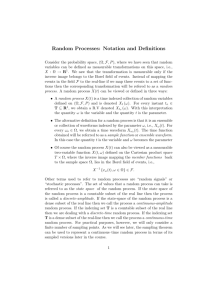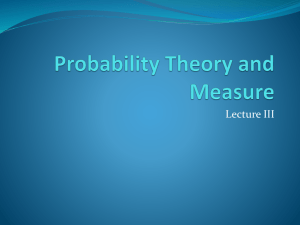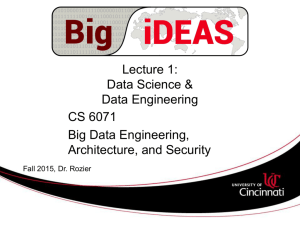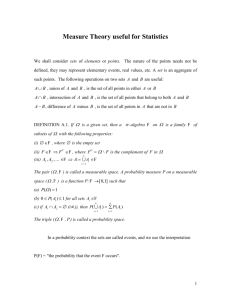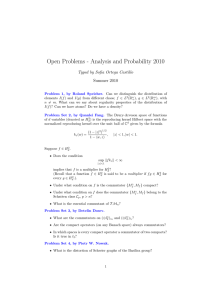HOMOMORPHISMS ACTIONS AND OF ERGODIC GROUP
advertisement
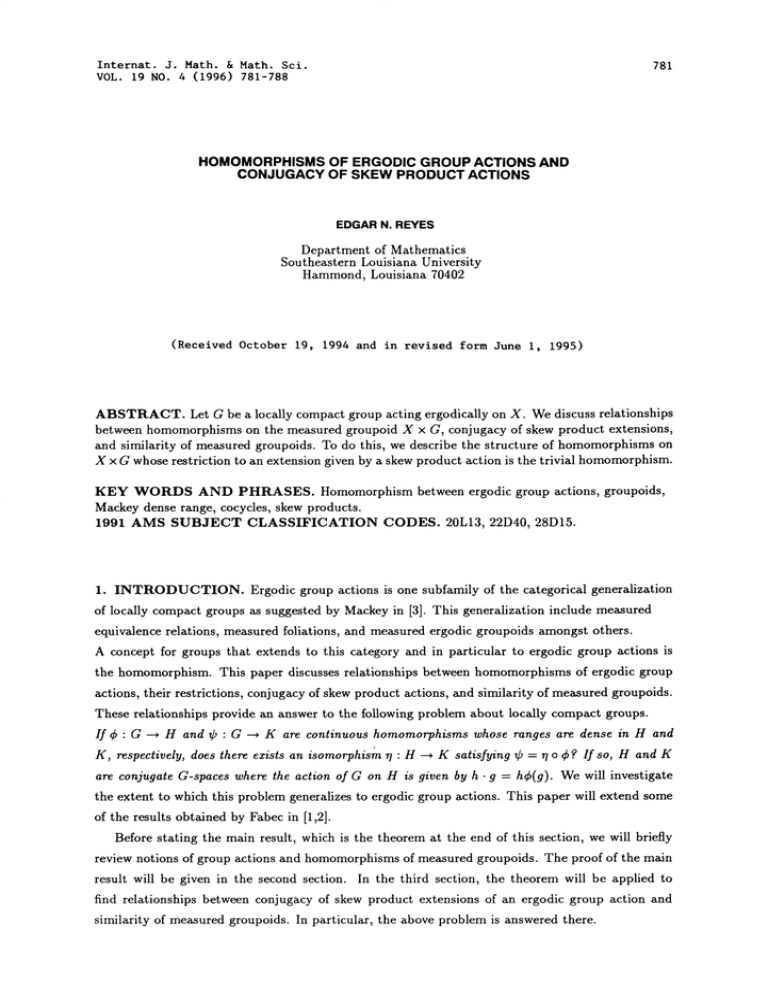
Internat. J. Math. & Math. Sci.
VOL. 19 NO. 4 (1996) 781-788
781
HOMOMORPHISMS OF ERGODIC GROUP ACTIONS AND
CONJUGACY OF SKEW PRODUCT ACTIONS
EDGAR N. REYES
Department of Mathematics
Southeastern Louisiana University
Hammond, Louisiana 70402
(Received October 19, 1994 and in revised form June i, 1995)
ABSTRACT. Let G be a locally compact group acting ergodically on X. We discuss relationships
between homomorphisms on the measured groupoid X G, conjugacy of skew product extensions,
and similarity of measured groupoids. To do this, we describe the structure of homomorphisms on
X G whose restriction to an extension given by a skew product action is the trivial homomorphism.
KEY WORDS AND PHRASES. Homomorphism between ergodic group actions, groupoids,
Mackey dense range, cocycles, skew products.
1991 AMS SUBJECT CLASSIFICATION CODES. 20L13, 22D40, 28D15.
1. INTRODUCTION. Ergodic group actions is one subfamily of the categorical generalization
of locally compact groups as suggested by Mackey in [3]. This generalization include measured
equivalence relations, measured foliations, and measured ergodic groupoids amongst others.
A concept for groups that extends to this category and in particular to ergodic group actions
is
the homomorphism. This paper discusses relationships between homomorphisms of ergodic group
actions, their restrictions, conjugacy of skew product actions, and similarity of measured groupoids.
These relationships provide an answer to the following problem about locally compact groups.
If G H and G K are continuous homomorphisms whose ranges are dense in H and
K, respectively, does there
are conjugate
o ? If so, H and K
isomorphisn H K satisfying
action of G on H is given by h.g
he(g). We will investigate
exists an
G-spaces where the
the extent to which this problem generalizes to ergodic group actions. This paper will extend some
of the results obtained by Fabec in
[1,2].
Before stating the main result, which is the theorem at the end of this section, we will briefly
review notions of group actions and homomorphisms of measured groupoids. The proof of the main
result will be given in the second section. In the third section, the theorem will be applied to
find relationships between conjugacy of skew product extensions of an ergodic group action and
similarity of measured groupoids. In particular, the above problem is answered there.
E.N. REYES
782
Let G be a second countable, locally compact group. Suppose # is a a-finite measure on a
z "9
standard Borel space X. Then X is a G-space provided there exists a Borel mapping (z, 9)
from X x G to X satisfying
(1) z. e z for all z,
(2) x.gx .92 z.9192 for all x,9,92, and
(3) (E-9) 0 if and only if (E) 0 for each 9 and Borel subset E.
Two G-spaces (Xa,#I) and (X,kt2) are isomorphic if there exists a Borel isomorphism
X X2 such that (x. g) ,(x).g /a-a.e. x for each g and (I).fi 10 (I) -a 2
.#x and #2 belong to the same measure class.
If (Y, u) is a G-space then a Borel map p: X
Y is called an extension if p(x’9) p(z)"9 for all
and
Two
extensions
u.
p.#
(Y,u) and P2: (X2, #2) (Y,u) are isomorphic
(z,9)
Pl: (X1,1)
over Y if there exists a G-space isomorphism from X1 to X2 such that p2 o (z) pl(z) a.e.z.
Let H be a complete separable metric group. A cocycle on the G-space (X,/z) with values in
X x G H satisfying (z,919.) (z,91)(z" 91,92) for all z,91,92. If
H is a Borel mapping
one defines (z,h).9
(x. 9, h(z,9)) then (X x H,# x ran) becomes a G-space where rnn is a
Haar measure on H. This G space is denoted by (X x H,# x mn) and is called the skew product
i.e.
:
action defined by the cocycle
.
The measure space (X x G, # x ma) is called the measured groupoid defined by the action of G
on (X, #). There is a partially defined multiplication on the groupoid, namely,
(z,991). Also, (x,9) -1 (x 9,9 -a) defines an inverse operation in the groupoid.
Given Zl, z2, z3, z4 E X x G, one can directly verify that
(z,9)(z 9,91)
if zlz2
z3
then
ZIz3 is well-defined and z2 z;lz3.
-
-
A homomorphism h X x G Y x H between measured groupoids
of Borel maps h (p, ) where p:X
Y and :X x G H satisfy
(1.1)
or group actions is a pair
(4) is a cocycle,
(5) p(x. g) p(x). (x, g) for all (x, g), and
(6) # (p-l(E)) 0 if and only if u(E) 0 whenever E is an invariant analytic subset of Y.
Statements (4) and (5) are necessary and sufficient conditions for h X x G Y x H to define
multiplicative mapping between groupoids. An action of G is ergodic if E is a null or conull Borel
subset whenever E.g E for all g. In case (X,#)is an ergodic G-space and (Y, u) is an ergodic
a
H-space, one says h is a homomorphism between ergodic group actions. In this case, as pointed out
by Ramsay in [5, page 394], statement (6) is equivalent to the condition: p-l(E) is null whenever
E is an invariant analytic null subset of Y.
Two homomorphisms h and h’ from X x G to Y x H are cohomologous or similar if there is
a Borel mapping A X
Y x H satisfying A(x)h(x,g) h’(x,g)A(x, g) a.e. (x,g). This will
be denoted by h
h’. The idea of isomorphic groups extends to the notion of similar measured
YxH
groupoids. Let id be the identity mapping. If there exist homomorphisms J X x G
idand J2oJ1
and J2 Y H--. X x Gfor which JaoJ2
id, then X x G and Y x H are
Y x H is said to be trivial
called similar measured groupoids. Also, a homomorphism h X x G
-
HOMOMORPHISMS OF ERGODIC GROUP ACTIONS
if there is a Borel mapping A X
Y x H satisfying
A(x)h(x,g)
A homomorphism h
Mackey dense range if
783
A(x. g)
a.e.
(x,g).
(p, ) X G Y H between ergodic group actions is said to have
(x,h) p(x)h-* provides an ergodic decomposition of the skew product
H. In particular, a cocycle has Mackey dense range in the locally compact group
G-space X
H if the skew product action is ergodic. An ergodic decomposition satisfies a universal property.
Namely, if f is a Borel function on X H with values in a countably separated Borel space and f
is essentially invariant, i.e. f(x. g, he(x, g)) f(x, h) a.e. (x, h, g), then there exists an essentially
unique Borel function F defined on Y such that F(p(x). h -) f(x,h) a.e. (x,h).
Y is
One can also restrict homomorphisms between measured groupoids. Indeed, if p0 X
an extension of G-spaces, the homomorphism given by i(z,g)
(po(z),g) from X G into Y G
is called an inclusion homomorphism. If h
(p, ) is a homomorphism of Y G into W H,
the composition h o is called the restriction of h to X G and will be denoted by hlxa. So
hlxa(x,g) (p(po(x)),(po(x),g)) for all (x,g). The main result of this paper is the following
theorem and it is an extension of Proposition 2.1 in Fabec [2].
THEOREM Let h (p, ) X x G Y x H be a homomorphism with Mackey dense range
and let b (q, ) X x G ---, Z x K be a homomorphism between ergodic group actions.
Then b a o h for some homomorphism a Y H
Z x K if and only if b[x,ga is trivial.
2. PROOF OF THEOREM. To organize and divide the proof, we will begin with two lemmas.
It will be shown that by changing a trivial homomorphism slightly
everywhere’ condition in (1.2) to one that will hold ’for all’.
K,
a
change the ’almost
W G K be a cocycle. Suppose W K
G-space and let
rl(w)(w,g
rl(w. g) a.e. (w,g). Then there exist a cocycle
Borel mapping A2 W
K, and a conull, Borel subset Wo of W with Wo" G
LEMMA 2.1 Let W be
a
is a Borel mapping such that
0: W x G
one can
Borel satisfying
-
(a) A2(w)o(w, g) A(w g) for all (w, g),
(b) 0(w, g) (w, g) for all w e Wo G and g 6 G, and
(c) A(w)= rl(w a.e. w.
-
-
{(w,g) rl(w) rt(w. g)(w,g)-l}. If (w, gl) and (w. ga,g) are in J then
() .d o
,(o. ala)(o,a,a)
,(o. ala)(o, aa,a)-’(o,a)-a (o. al)(o,)
(w, gigs) J. Since J is a conull, multiplicatively closed Borel subset of the groupoid W G, then
by Lemma A.4 in Fabec [2] and Lemma 5.2 in Ramsay [4] there is a Borel, conull subset W0 of W
PROOF. Let J
such that
(i) if w, w .g W0 then (w,g) J,
(ii) W0" G is a Borel subset, and
(iii) there exists a Borel mapping 0 W0" G
nd w. 0(o) e W0 for all o e W0" G.
G such that O(w)
e if w
e W0,
E.N. REYES
784
Wo. G then define As(w) zi(w O(w))(w,O(w)) -1
As(w) e.
Let o" W x G g be the cocycle defined by o(w,g) (w,g) if w E Wo" G, and if w Wo" G
set o(w,g)
e. If w
Wo" G,g G then (w. O(w),O(w)-gO(w g)) J, and cosequently,
-1
g)Vo(w,
g)
A(w
(w gO(w g)) (w g, O(w g))-’ (w, g)
(o()) (. o(), o()-gO(, g)) (, go(. g))-’
(. go(. g)) (, go(. g))-I
A(w). Hence, A=(w.g)o(W,g)-’ A=(w) for all (w,g).
If w E
otherwise set
-
LEMMA 2.2 Let b (q, ): W x G Z x K be a trivial homomorphism between
measured groupoids. Then there exist Borel mappings bo (qo, o) W G -+ Z K,
Ao (A1, A2): W Z x K, and a conull, Borel subset Wo of W with Wo" G Borel satisfying
W x G g is a cocycle where o(w,g) (w,g) for all w Wo G and g e G,
(a)
o:
(b) q(w)= qo(w) a.e w, and
(c) Ao(w)bo(w,g) Ao(w. g) for all (w,g).
(, r/) W Z x K be a Borel mapping satisfying
((w), y(w))(q(w), (w,g)) ((w. g),y(w, g)) a.e. (w,g). By Lemma 2.1 we can choose a cocycle
o: W x G -, K, a Borel mapping A2 W K, and a conull, Borel subset Wo with Wo" G Borel
such that (a)- (c) of Lemma 2.1 holds. Let g
((w,g): (w) (w. g)}. Since g is a conull,
multiplicatively closed Borel subset of the groupoid W x G then by Lemma A.4 in Fabec [2] and
Lemma 5.2 in Ramsay [4] there exists a conull, Borel subset W of W such that
(i) if w, w .g G W then (w,g) J,
(ii) Wx. G is a Borel subset, and
(iii) there exists a Sorel mapping 0: W-G G where O(w) e for w E W1, and
0() e w, for n e w. G.
Let A W
Z be the Borel mapping given by Al(W)
(w. O(w)) if w e W1. G and if
w
W1 G set Al(w) zo where zo is some fixed element of Z independent of w. If w W1 G
then (wO(w),O(w)-lgO(w g)) g and so Al(w. g)
(w gO(w. g))
(TO(w)) Al(W). Thus,
Al(w" g)-- Al(w) for all (w,g).
Define a Borel map qo: W
Z by letting qo(w) Ai(w)A(w). Since A(w) rl(w a.e. w
and (w). r(w) q(w) a.e. w then qo(w) q(w) a.e.w. Set bo (qo, 0) and Ao (A,A).
[]
Then (Al(w),A(w))(qo(w), o(w,g)) (Ai(w. g),A2(w, g)) for all w,g.
PROOF. Let A
.
-
Turning to the proof of the Theorem, suppose b
equivalence relation, one can assume b a o h. If A(x, h)
a o
h. Since ’cohomologous’ defines an
a(p(x)h -1, h) then A(x, h)b(x, g)
a(p(x)h -1, h)a(p(x), (x, g)) a(p(x)h -1, he(x, g)) a(p(xg)(x, g)-X h-, he(x, g))
A(xg, h(x,g)). Thus, A(x,h)b(x,g) A((x,h). g) for all (x,h),g and blxHxa is trivial.
H x G Z K is trivial. According to Lemma 2.2,
Conversely, suppose blxx,Hx G X
with W X x H, there are Borel mappings bo (q0, o) X
H G Z x K and
Ao (A1, As) :X x H Z x K and conull Borel subsets Wo, W2 C_ X H, with Wo" G Borel
for which
(a) 0 is a cocycle and Co(x, h,g) (x,g) for all (x, h)
(b) q(x)= qo(x,h) for all (x,h) W2, and
(c) Ao(x,h)bo(x,h,g)= Ao(x. g,h(x,g)) for all x,h,g.
Wo" G,g G,
HOMOMORPHISMS OF ERGODIC GROUP ACTIONS
785
Let W3 W2 fq (W0. G). Then bo(x,h,g)
Set E
(x,h,),(x,h’hl) 6
and
mo(x,h{lh)b(x,g)
Ao(x.g,h,(x,g))
b(x,g) for all (x,h) 6 W3, g 6 G.
If (x,h,h2) 6 E, g 6 G then Ao(x,h)b(x,g)
{(x,h,h2)
Ao(x.g,h{ahl(x,g)). In particular, by (1.1),
-1
Ao(x, hl)Ao (x,hlh) is a well-defined element of Z x K for all (x,h,h) 6 E. Fix a point
z0in ZanddefineaBorelmappingF:XxCHxHZxKby
Wz}.
Ao(x,h,)Ao(z,h{*hl)
F(x,h,,h2)
Given g
-
if(x,h,,h)6E
(z0, e)
otherwise.
E such that (x.g, ha(x,g),h)
G,(x,h,h2)
Ao(x,h)Ao(x,hh)
-1
E, then F(x.g, ha(x,g),h)
F(x,h,h). Since E is a conull, Borel subset and (x, h)
-
, h)
p(x)h? is an
Z x K satisfying a (p(z)h;
ergodic decomposition, there exists a Borel mapping a: Y x H
-
(x,h,h). Moreover, a(p(x)h-,hh) (x,h) (x,hh{h)
(x, h)
(x,h;ah) (x,hhh) a(p(x)h-,h)a(p(x)h-h,h)
a.e. (x,h,h,h), and hence, a is almost multiplicative. By Proposition A.7 in Fabec [2], one c
ao(x,h)ao(x,hha)
-1
a.e.
(x,h;h)-aao
sume a is strictly multiplicative. Since a is given as a pair of Borel maps, there exist a Borel
function s Y
Z and
a
cocycle y Y x H
K which by definition satisfies
OI(X, hl),A2(,hlOI(x,hlhl). A(z,h’h),A(z,h’h,)-
-
(2.1)
(x,h,h). So y (p(x)h;a,h) A(x,h)A(x,hh) a.e. (x,h,hz). Set L(x,h)=
A(x,h)- (p(x)h-,h). Then L(x,hlh) A2(x,hh)- (p(x)h;ah2, hh)
for a.e.
(x,h,h). Since G is the only conull mutiplicatively closed subset of a group, L(x,hh)
L(x, h) a.e. h, for each h, a.e.x. Thus, by Lemma A.3 in Fabec [2], there exists a Borel mapping
B: X g such that B(x) L(x, h) -x a.e. (x, h). It follows from the definition of n(x, h) that
a.e.
A(, )
(p()-, ) ()
a.,.
(, )
(.)
and so
A (z g,h(x,g))
(p(x g)(x,g)-lh-a,h(x,g)) B(x g)
r (p(x)h-,h) rl(p(x),(x,g))B(x, g)
A2(x,h)B(x)-lq(p(x),(x,g))B(x. g)
a.e.
a.e.
(x,h) for each g. On the other hand, A2(x. g,h(x,g)) A2(x,h)o(x,h,g)
(x, h, g) by (a) and (c). Together with (2.3), one obtains
(x,g)
B(x)-Irl(p(x),(x,g))B(x.g)
a.e.
(x,g).
(2.3)
A2(x,h)(x,g)
(2.4)
Since s(p(x)h -) Aa(x,h)a.e. (x,h) by (2.1)and Aa(x,h)Ag.(x,h)= qo(x,h) for all (x,h) by
(c), then q(z)= s(p(z)h-)A(z,h) a.e. (x,h) by (b). Combining this with (2.2), one has
q(x) s (p(x)h -1) q (p(x)h -1, h) B(x) s (p(x)) B(x) a.e.x.
786
E.N. REYES
Let r: X Z be the Borel function given by r(x)
s (p(x))0 (p(z), (x,g))
s (p(z. g))
s (p(z)(x,g))
(p(x)), (p(x), (x,
(p(x)). So q(x) r(x)B(x) a.e. x and
r(x. g). Thus, by (2.4), one obtains
a.e. (x, g).
g), B(x.
Finally, we have to show a (s, r) satisfies (6) of the definition of a homomorphism. Let Z0
be an invariant analytic null subset of Z. So {x: s(p(x)) E Z0} is null iff {x: q(x)B(x) -1 e Z0}
is null iff {x: q(x) Zo" B(x)} is null iff {x: q(x) Z0} is null. Since b is a homomorphism,
(p- o s -1) (Z0) is null. Since h is a homomorphism and s-(Zo) is an invariant analytic subset of
Q
Y, s-X(Zo) is null. Thus, a is a homomorphism and b is cohomologous to a o h.
(r(x), B(x))(q(x), (x,g)) (s
s
g)))(r(x,
g))
SKEW PRODUCT ACTIONS. In this section, the Theorem is applied to study the
relationship between conjugacy of skew product actions and similarity of groupoids. The following
proposition is itself interesting and will be useful.
3.
Y x H be a homomorphism with Mackey
(p,) X x G
x
x
(q, ) Y H Y H is a homomorphism such that J o h h.
(y,h).
PROPOSITION 3.1 Let h
dense range and suppose J
Then J
id where id(y,h)
PROOF. Choose
a Borel mapping
B
(Ba,B2) :X
Y x H satisfying
(x,g). By Fubini’s Theorem, equation (3.1) holds a.e. x for a.e.g. But the set of all g for
which there exists a conull Borel subset Xg of X, depending on g, so that (3.1) holds on Xg
is a multiplicatively closed subset of G. Since G is the only conull multiplicatively closed subset of
G, then (3.1) holds a.e. x for each g.
g given by F(x, ha, h.)
Consider the mapping F: X H H
Then F (x -g, h (x, g), h) h aha (x, g)B.(x, g) (p(x. g), (x, g)-a hi’
ha hl B2(x) (p(x), (x,g)) (p(x g), (x, g)-l h;l h2) hl hl B2(x)(p(x), h’lh2) F(x, ha, h2)
a.e. x, for each g, hl, and h2. Since F is invariant in its first two variables and (x,h) ---, p(x)h -1 is
an ergodic decomposition of X x H, there exists a Borel mapping C Y H
H for which
a.e.
h)
C(p(x)h[a,h)
Define r/: X
g
-
hahlB(x)g2(p(x),h[ah2)
a.e.
-
(x,h,,h).
(3.2)
H by r/(x, hi)-- hlB2(x)(p(x),h[1). By using (3.1), rl(x.g, ha(x,g))=
haB(x)(p(x),h a) q(x,h) a.e. x for each g,h. Since J has Mackey dense range,
(x, h) p(x)h is an ergodic decomposition of the the skew product G-space X H and thus
there exists a Sorel mapping
Y H such that (p(x)h a) haB(x)(p(x),h[ a) a.e. (x, ha).
From (3.2), one finds C(p(x)h 1, h) h h, B(x)(p(z), h[’ )(p(x)h[ h2)
h(p(x)ha)(p(x)h[a,h) a.e. (x, ha, h). Also, by the definition of and (3.2), one
obtains (p(x)h-[lh) hhaB(x)(p(x),hlh) C(p(x)h[a,h) a.e. (x, ha,h).
Consequently, h(p(x)h[ h)
(p(x)h[ ) (p(x)h a, h) a.e. (x, h, h). Thus,
,
:
(y)(y, h)
h2(y, h)
a.e.
(y, h).
(3.3)
HOMOMORPHISMS OF ERGODIC GROUP ACTIONS
787
(3.1) and the fact that J is a homomorphism, one finds
p(x)h[l(p(x)h[ 1) p(x)h[ hiB2(x)(p(x), hi ) p(x)B(x)(p(x), hi )
B(z)B(x)(p(x),h[ ) q(p(z))(p(z),h’) q(p(z)h[ 1) a.e. (z, hl). Thus, y-(y) q(y) a.e.
[]
y and by (3.3), (y,f(y))(q(y),(y,h))=(y,h=)(y.h,f(y.h))a.e. (y, h2). Hence, g..id.
On the other hand,
as a consequence
of
.
COROLLARY 3.2 Let :X x G H be a cocycle with Mackey dense range.
Then J is an inner conjugation.
Suppose J zs an endomorphism of H such that J o
PROPOSITION 3.3 Suppose h (p, ):X x G Y x H and
h’ (p’, ’) X x G Y’ x H’ are homomorphisms with Mackey dense range. If the skew product
G spaces X x H and X x H’ are conjugate extensions of X then Y x H and Y’ x H’ are similar
groupoids.
,
PROOF.
If X
x H and X
, H’
are conjugate extensions of
X then there is
a Borel
H H’ satisfying (z. g,h(z,g))
(z,h). ’(z,g) a.e. (z,h) for each g.
Y’ be the Borel mapping given by c(z, h) p’(z).f(z, h) Then c is G-invariant
since c ((z, h)- g) p’(z.g)(z.g, he(z, g))- p’(z.g)’(z, g)-(z, h)
p’(z)(z, h)
a(z, h)
a.e. (z,h) for all g. Consequently, ((z,h),f(z,h))(p’(z),’(z,g))
(a((z,h).g),f((z,h).g))
a.e. (z,h) for all g and so h’lX x H x G is trivial. Similarly, hlX
H’ G is trivial.
By the Theorem, there must exist homomorphisms J and J’ such that J’ o h’ h and J o h h’.
Thus, J’ o J o h h and J’ o J id follows by Proposition 3.1 Similarly, J o J’ id.
[3
This shows Y H and Y’ H’ are similar groupoids.
In Proposition 3.3, if Y and Y’ are points one obtains an interesting corollary that extends
Theorem 1.3 in Fabec [1]. Also, if X is a point, the problem stated in the introduction is answered.
mapping
f: X
-, -.
Let c: X H
COROLLARY 3.4 Suppose
:X x G
H and
XxG
K
are
cocycles with Mackey
dense range. Then the following are equivalent
(a) restricted to X x K x G and restricted to X x H x G are both trivial
(b) there is an isomorphism J from H onto g such that J o is cohomologous to
(c) the skew product actions of G on X x H and on X x K define
conjugate extensions
of X.
.
.
PROOF. If (a) holds then by the Theorem, there are homomorphisms J H K and
and J2 o J o
and J o
So J o J o
J. K H such that Jl O
By Corollary 3.2, J1 must be an isomorphism and (b) is proved.
If (b) holds then there is a Borel map A: X
K satisfying J((x,g)) A(z)(x,g)A(x. g)a.e. z for each g. Let
X xcH X xcK be the function given by (x, h) (x,J(h)A(z)). Then
:
-
(x. g,h(x,g)) (x. g,J(h)J(x,g)A(x, g)) (x. g,J(h)A(x)(x,g)) (x,h).g a.e. (x,h)
Note, is a Borel isomorphism whose inverse is given by l(x,k) (x,g (kA(x)-)).
mg where mH and mg are Haar measures
Moreover, a direct calculation shows .(# mH)
on H and K, respectively. Thus, X
K are conjugate extensions of X.
H and X
[]
Finally, in the proof of Proposition 3.3 it is shown (c) implies (a).
for each g.
788
E.N. REYES
ACKNOWLEDGEMENT. wish to thank the referee for suggesting a number of remarks and
modifications on an earlier version of this paper. Finally, the results found here rest on ideas
generously shared by Professor Fabec and to whom am indebted.
REFERENCES
FABEC, R.C., Cocycles, extensions of group actions, and bundle representations,
J. Funct. Anal. 56 (1984), 79-98.
2. FABEC, R.C., Induced group actions, representations and fibered skew product extensions,
Trans. Arner. Math. Soc. 301 (1987), 489-513.
3. MACKEY, G.W., Ergodic theory and virtual groups, Math. Ann. 166 (1966), 187-207.
4. RAMSAY, A., Virtual groups and group actions, Adv.in Math. 6 (1971), 253-322.
5. RAMSAY, A., Subobjects of virtual groups, Pacific J. Math. 87 (1980), 389-454.
1.

